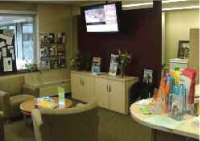Employment Articles

Learning Through Space
Inside U of M’s New Career Centre
BY JASON RHYNO

A career centre is your life line to full and part-time employment and helps you make that tricky transition from school to career. The array of services offered vary from campus to campus, but every now and then, we here at jobpostings hear of a particular career centre that is going above and beyond.
Students with disabilities often face barriers that other students do not. That’s a key fact that every career centre should take into account. For this issue, we wanted to go inside and take a tour of the recently renovated University of Manitoba’s career centre. What changes were made? How has this benefitted the students? What are the career counsellors like and how can they help you?
Structurally Speaking
The renovation of U of M’s career centre was the final step of a departmental reorganization, explains David Ness, counsellor, associate professor and coordinator of career services. “Approximately two years ago we took two separate departments and put them into one. Career counselling used to be in student counselling and career services, but the employment services – job search, resumé, career fairs – were in a separate department. This works better because somebody might be struggling to find work but the issue might be social anxiety.”
The structural renovations that were implemented allow for the space to be more flexible, Ness says of the design, as well as making it a little more welcoming to students. “We took out some permanent desks that were built into the floor and other structures that really kind of broke up the space and made it very open.” This allowed room for additional services, like a large screen television that plays different videos during the day. It also allows room for re-configuration, turning the space into a small theatre that can hold 20 to 40 people, making it much more conducive for presentations. “We’ve updated all of our computer work stations, so we have five computers the students can use for career planning purposes and added some staff in that space too.”
The flexibility of the space allows for more open learning, Ness explains. It’s more public and if an individual student is in the space they will pick up on that information. “We find that sometimes that passive kind of learning is a wonderful opportunity.”
Above and Beyond
Any career centre is only as good as the counsellors.“They like to get into a discussion with the students, a dialogue.”
Added to that is the constant availability of the counsellors. No appointment is needed and you won’t wait longer than an hour. “There is always someone in there to talk whereas before that wasn’t the way things were configured in our space,” Ness says.
The Broad Spectrum
“We certainly see the broad spectrum of students with disabilities, from psychological to physical to learning disabilities,” Ness says, adding that his wife used be director of disability services for a number of years.
While they don’t have specific programming tailored for students with disabilities, counsellors like Ness are able to accommodate any specific needs. They also see you for you while taking into account the disability. “We try to get a really good understanding of what the disability is and the impact that has on their life and their career plans. One of the major challenges is to help the student understand what their disability really means. “What I found is that students with physical disabilities have a really good understanding of how that impacts careers, but typically they might be over-limiting their options and may see it as more of an impediment than it may be.” Conversely, it’s common for students who have hidden disabilities not to understand what the disability is and how it relates to career work. “So we have to do some work with those students,” he says.
Ness is passionate about his work. “The success stories that are most meaningful to me are when students with disabilities come in feeling very discouraged, not having much hope, and we get them excited about something and get them seeing that there are possibilities. Their disabilities do not have to sabotage life and happiness.”

 Quick Question:
Quick Question:

